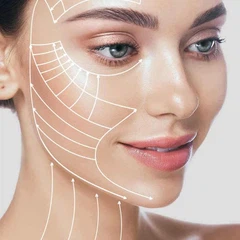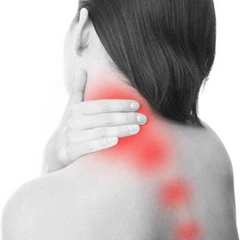Introduction
As we age and collagen loss occurs, our skin gradually becomes loose, sagging, and develops fine lines. To restore a firmer, more youthful appearance, more people are turning to safe and effective non-surgical skin tightening options. Among the many technologies available, HIFU (high-intensity focused ultrasound) and RF (radiofrequency skin tightening) are two popular non-invasive treatments. While both stimulate collagen regeneration and improve skin elasticity, their principles and application scenarios differ. This article systematically analyzes the differences between these two mainstream technologies, HIFU and RF, providing a professional guide for choosing the right one.

What Is HIFU Technology?
The core of HIFU (High-Intensity Focused Ultrasound) technology is to leverage the penetrating and focused properties of ultrasound to precisely deliver energy deep into the skin, even down to the SMAS fascia. During treatment, the device releases energy through probes at varying depths (1.5mm, 3.0mm, and 4.5mm). This creates a thermal coagulation point of 65-70°C in the target layer, triggering the body's natural repair mechanisms and stimulating collagen regeneration, achieving deep-seated skin firming and contour enhancement.

Application Scenarios
HIFU addresses a full range of skin needs, from superficial skin texture to deeper contouring:
• Superficial Improvement (1.5mm): Targets epidermis and superficial dermis. Improves early aging signs (eye fine lines, crow's feet, forehead wrinkles), shrinks pores (nose/cheeks), and fixes dullness from late nights by stimulating superficial collagen. Delivers brighter, smoother skin.
• Mid-Layer Firming (3.0mm): Energy penetrates deep into the dermis, helping to tighten minor sagging in the cheeks and apples of the cheeks, improve early-stage fine lines in the neck, and restore elasticity and volume. Ideal for those with mild to moderate sagging.
• Deep Lifting (4.5mm): Directly reaches the SMAS fascia layer, fundamentally rebuilding the skin's support structure. It's particularly effective for aging-related facial contour collapse, such as a double chin, blurred jawline, and prominent nasolabial folds. The results are comparable to non-surgical facelifts, re-lifting and tightening the overall contour.
Treatment Experience and Recovery Period
• Feeling of Pain: HIFU is minimally painful when applied to the superficial layers. When the energy is focused on the deeper layers, a more noticeable stinging or soreness may be experienced.
• Post-Operational Effects: Treatments for superficial and mid-layers produce little to no redness or swelling, allowing makeup to be applied the same day. Deeper layers may cause slight redness, which subsides within a few hours to a day, ensuring no disruption to work or appointments.
• Recovery Period Management: Avoid high temperature environments and gravity massage within 1 week after deep treatment, and strengthen hydration and moisturizing. No special care is required for shallow/middle layer treatment, and normal moisturizing and sun protection are sufficient.
What Is RF Technology?
RF (radio frequency) technology applies electromagnetic energy to skin tissue via radiofrequency waves. This energy is absorbed by water molecules in the dermis and converted into heat, raising the dermis' temperature to 40-45°C. This warming effect directly causes existing collagen fibers to contract while activating fibroblast activity and promoting new collagen synthesis. Unlike the point-focused HIFU technique, RF energy delivers volumetric heating, allowing for more uniform application to the target area. The depth and heat distribution can be controlled by adjusting device parameters.

Multi-Mode
RF technology offers various modes: monopolar, bipolar, or multipolar, and microneedle. Newangie's microneedle RF device combines microneedle technology with radiofrequency (RF) energy. Compared to traditional RF technology, microneedle RF offers more precise energy penetration, less surface damage, and superior anti-aging effects.
Multi-Area Compatibility
It can be used on multiple areas, including the face, neck, abdomen, and arms. It generally focuses on improving both the epidermis and dermis, addressing both facial anti-aging and body contouring needs. Newangie's Youshape ID Flex RF, for example, targets body contouring, tightening the skin through deep thermal stimulation, sculpting the body, and reducing the appearance of cellulite.
Treatment Experience and Recovery Period
• Feeling of Pain: The treatment is primarily a warm and comfortable sensation, similar to a "hot compress," less painful than HIFU.
• Post-Operational Effects: There is no noticeable epidermal trauma. A few may experience temporary redness, which usually subsides within 30 minutes, with no downtime.
• Convenient Care: You can immediately apply makeup and normal skincare after treatment, requiring only increased moisturizing and sun protection. It does not interfere with daily life.
Comparison of HIFU and RF Skin Tightening Technology
The following table compares the two technologies:
|
Category |
HIFU (High-Intensity Focused Ultrasound) |
RF (Radio Frequency) |
|
Principle |
Focused ultrasound heats deep layers (dermis to SMAS). |
RF energy evenly heats the dermis. |
|
Depth |
1.5–4.5 mm (reaches SMAS). |
0.5–3 mm (does not reach SMAS). |
|
Main Effect |
Deep lifting and contour tightening. |
Texture improvement, fine lines reduction, mild firming. |
|
Best For |
35 + years, visible sagging or deep folds. |
25–40 years, dull skin or mild laxity. |
|
Comfort |
Slight soreness in deep layers. |
Gentle warmth, painless. |
|
Results |
Visible in 1–2 weeks, peak at 1–3 months. |
Gradual improvement after 3–6 sessions. |
|
Duration |
12–18 months (single session). |
6–9 months (after full course). |
|
Risks |
Possible fat layer damage if misused. |
Mild redness or dryness. |
|
Areas |
Face contour (jawline, cheeks, folds). |
Facial skin and body (eyes, abdomen, arms). |
Technology Selection: Precisely Matching Needs and Scenario
Which is better, HIFU or RF? There's no definitive answer. The key is to align your skin concerns with your improvement goals.
Choose Based on Skin Priorities
• Emergency Contouring Needs: For those with age-related concerns (such as a blurred jawline, a prominent double chin, or sagging skin), HIFU is the preferred choice. It targets the SMAS fascia layer, quickly rebuilding the facial support structure.
• Overall Skin Enhancement: If your primary concern is skin texture, such as enlarged pores, noticeable fine lines, or rough, inelastic skin, RF technology can stimulate dermal collagen regeneration throughout the skin layer. Long-term use can lead to firmer, more refined skin.
• Anti-aging Body Treatment: For those with a firm abdomen and excess arm fat, monopolar RF can effectively tighten large areas of subcutaneous tissue, creating a smoother, firmer body contour.
Choose Based on Age and Skin Type
• Preventive Anti-Aging (25-35 years): At this stage, skin begins to experience collagen loss but hasn't yet experienced noticeable sagging. Radiofrequency technology gently stimulates collagen regeneration and maintains skin elasticity.
• Corrective anti-aging (ages 35-50): Fascial laxity leads to sagging contours. HIFU's deep-level intervention can precisely address the core issue.
• Senile anti-aging (ages 50 and older): Thinning skin and insufficient collagen reserves can be treated with low-energy HIFU combined with radiofrequency. This can improve contours and skin texture while reducing the risks of a single treatment.
Choose Based on Treatment Expectations and Budget
• Highly Effective and Long-Lasting: If you're looking for a treatment lasting more than a year and can tolerate minimal pain and a higher budget, HIFU is a more economical option.
• Gentle and Gradual: If you seek a comfortable treatment experience and desire gradual improvement over the course of treatment, radiofrequency technology better meets your expectations and offers a more affordable price per treatment.
Conclusion
HIFU and RF are both mainstream non-invasive skin tightening technologies. Both stimulate collagen regeneration, but their core differences are significant. We hope that through this article, you will have a clearer understanding of these two technologies and be able to choose the most suitable device.
Newangie has been dedicated to the research and development, and manufacturing of aesthetic devices for over 17 years, providing high-quality HIFU and RF devices. We can also offer OEM/ODM services for your medical aesthetics business, offering a one-stop service from design, development, manufacturing, to delivery. Please contact us for more information.











